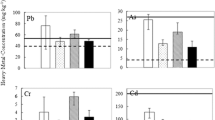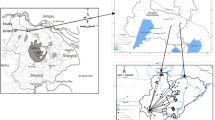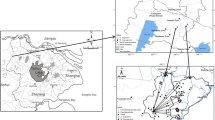Abstract
Biogas slurry is a product of anaerobic digestion of manure that has been widely used as a soil fertilizer. Although the use for soil fertilizer is a cost-effective solution, it has been found that repeated use of biogas slurry that contains high heavy metal contents can cause pollution to the soil-plant system and risk to human health. The objective of this study was to investigate effects of biogas slurry on the soil-plant system and the human health. We analyzed the heavy metal concentrations (including As, Pb, Cu, Zn, Cr and Cd) in 106 soil samples and 58 plant samples in a farmland amended with biogas slurry in Taihu basin, China. Based on the test results, we assessed the potential human health risk when biogas slurry containing heavy metals was used as a soil fertilizer. The test results indicated that the Cd and Pb concentrations in soils exceeded the contamination limits and Cd exhibited the highest soil-to-root migration potential. Among the 11 plants analyzed, Kalimeris indica had the highest heavy metal absorption capacity. The leafy vegetables showed higher uptake of heavy metals than non-leafy vegetables. The non-carcinogenic risks mainly resulted from As, Pb, Cd, Cu and Zn through plant ingestion exposure. The integrated carcinogenic risks were associated with Cr, As and Cd in which Cr showed the highest risk while Cd showed the lowest risk. Among all the heavy metals analyzed, As and Cd appeared to have a lifetime health threat, which thus should be attenuated during production of biogas slurry to mitigate the heavy metal contamination.





Similar content being viewed by others
References
Ahmad JU, Goni MA (2010) Heavy metal contamination in water, soil, and vegetables of the industrial areas in Dhaka, Bangladesh. Environ Monit Assess 166:347–357
Al-Hwaiti M, Al-Khashman O (2015) Health risk assessment of heavy metals contamination in tomato and green pepper plants grown in soils amended with phosphogypsum waste materials. Environ Geochem Health 37(2):287–304
AQSIQ (2001) Safety qualification for agricultural product-safety requirements for non-environmental pollution vegetable. General Administration of Quality Supervision, Inspection and Quarantine of China (GB18406.1-2001)
Baig JA, Kazi TG (2012) Translocation of arsenic contents in vegetables from growing media of contaminated areas. Ecotoxicol Environ Saf 75:27–32
Bermudez GMA, Jasan R, Plá R, Pignata ML (2011) Heavy metal and trace element concentrations in wheat grains: assessment of potential non-carcinogenic health hazard through their consumption. J Hazard Mater 193:264–271
Bermudez GMA, Jasan R, Plá R, Pignata ML (2012) Heavy metals and trace elements in atmospheric fall-out: their relationship with topsoil and wheat element composition. J Hazard Mater 213–214:447–456
Bolan NS, Khan MA, Donaldson DC, Matthew C (2003) Distribution and bioavailability of copper in farm effluent. Sci Total Environ 309:225–236
Boshoff M, Jordaens K, Baguet S, Bervoets L (2015) Trace metal transfer in a soil–plant–snail microcosm field experiment and biomarker responses in snails. Ecol Indic 48:636–648
Cai LM, Xu ZC, Ren MZ, Guo QW, Hu XB, Hu GC, Wan HF, Peng PG (2012) Source identification of eight hazardous heavy metals in agricultural soils of Huizhou, Guangdong Province, China. Ecotoxicol Environ Saf 78:2–8
Cao HB, Chen JJ, Zhang J, Zhang H, Qiao L, Men Y (2010) Heavy metals in rice and garden vegetables and their potential health risks to inhabitants in the vicinity of an industrial zone in Jiangsu, China. J Environ Sci 22(11):1792–1799
Chien LC, Hung TC, Choang KY, Yeh CY, Meng PJ, Shieh MJ, Han BC (2002) Daily intake of TBT, Cu, Zn, Cd and As for fishermen in Taiwan. Sci Total Environ 285:177–185
Demirevska-Kepova K, Simova-Stoilova L, Stoyanova Z, Ho ¨lzer R, Feller U (2004) Biochemical changes in barley plants after excessive supply of copper and manganese. Environ Exp Bot 52:253–266
Fritioff A, Greger M (2006) Uptake and distribution of Zn, Cu, Cd, and Pb in an aquatic plant Potamogeton natans. Chemosphere 63:220–227
Green ID, Tibbett M (2008) Differential uptake, partitioning and transfer of Cd and Zn in the soil-pea plant-aphid system. Environ Sci Technol 42:450–455
Harmanescu M, Alda LM, Bordean DM, Gogoasa I, Gergen I (2011) Heavy metals health risk assessment for population via consumption of vegetables grown in old mining area; a case study: Banat County, Romania. Chem Cent J 5:64
Huang ML, Zhou SL, Sun B, Zhao QG (2008) Heavy metals in wheat grain: assessment of potential health risk for inhabitants in Kunshan, China. Sci Total Environ 405:54–61
Jamali MK, Kazi TG, Arain MB, Afridi HI, Jalbani N, Kandhro GA, Baig JA (2009) Heavy metal accumulation in different varieties of wheat (Triticum aestivum L.) grown in soil amended with domestic sewage sludge. J Hazard Mater 164(2):1386–1391
Khan S, Rehman S, Khan AZ, Khan MA, Shah MT (2010) Soil and vegetables enrichment with heavy metals from geological sources in Gilgit, northern Pakistan. Ecotoxicol Environ Saf 73:1820–1827
Khan K, Lu YL, Khan H, Ishtiaq M, Khan S, Waqas M, Luo W, Wang TY (2013) Heavy metals in agricultural soils and crops and their health risks in Swat District, northern Pakistan. Food Chem Toxicol 58:449–458
Li FL, Yuan J, Sheng GD (2012a) Altered transfer of heavy metals from soil to Chinese cabbage with film mulching. Ecotoxicol Environ Saf 77:1–6
Li QS, Chen Y, Fu HB, Cui ZH, Shi L, Wang LL, Liu ZF (2012b) Health risk of heavy metals in food crops grown on reclaimed tidal flat soil in the Pearl River Estuary, China. J Hazard Mater 227:148–154
Mahmood A, Malik RN (2014) Human health risk assessment of heavy metals via consumption of contaminated vegetables collected from different irrigation sources in Lahore, Pakistan. Arab J Chem 7(1):91–99
Malik RN, Husain SZ, Nazir I (2010) Heavy metal contamination and accumulation in soil and wild plant species from industrial area of Islamabad, Pakistan. Pak J Bot 42(1):291–301
MEP (2008) Environmental quality standards for soils. Ministry of Environmental Protection, China.GB15618-2008. (in Chinese)
Meza-Figueroa D, De la O-Villanueva M, De la Parra ML (2007) Heavy metal distribution in dust from elementary schools in Hermosillo, Sonora, México. Atmos Environ 41:276–288
Ministry of Environmental Protection the People’s Republic of China (2014) Technical guidelines for risk assessment of contaminated sites.25-38
Ministry of Health, PRC (1991) Tolerance limit of zinc (GB13106-91) in foods. Beijing: Standards Press of China. (in Chinese)
Ministry of Health, PRC (1994) Tolerance limit of copper (GB15199-94) in foods. Beijing: Standards Press of China. (in Chinese)
Oliver MA (1997) Soil and human health: a review. Eur J Soil Sci 48:573–592
Reeves PG, Chaney RL (2001) Mineral nutrients status of female rats affects the absorption and organ distribution of cadmium from sunflower kernels (Helianthus annuus L.). Environ Res 85:215–225
Río M, Franco-Uría A, Abad E, Roca E (2011) A risk-based decision tool for the management of organic waste in agriculture and farming activities (FARMERS). J Hazard Mater 185:792–800
Saadia RT, Nabila R (2013) Multivariate analysis of metal levels in paddy soil, rice plants, and rice grains: a case study from Shakargarh, Pakistan. J Chem 2013:1–10
Shan Y, Tysklind M, Hao F, Ouyang W, Chen S, Lin C (2013) Identification of sources of heavy metals in agricultural soils using multivariate analysis and GIS. J Soils Sediments 13(4):720–729
Shi JC, Yu XL, Zhang MK, Lu SG, Wu WH, Wu JJ, Xu JM (2011) Potential risks of copper, zinc, and cadmium pollution due to pig manure application in a soil–rice system under intensive farming: a case study of Nanhu, China. J Environ Qual 40:1695–704
Szolnoki Z, Farsang A (2013) Evaluation of metal mobility and bioaccessibility in soils of urban vegetable gardens using sequential extraction. Water Air Soil Pollut 224(10):1737–1743
USEPA.2000. (United States Environmental Protection Agency). Handbook for non-cancer health effects evaluation. Washington (DC): US Environmental Protection Agency, Washington
USEPA, 2006. USEPA region III risk-based concentration table: technical back-ground information. United States Environmental Protection Agency, Washington
USEPA (2010) Risk-based concentration table. Unites States Environmental Protection Agency./http://www.epa.gov/reg3hwmd/risk/human/index.htm Accessed 12 Aug 2011
Wang G, Su M, Chen Y (2006) Transfer characteristics of cadmium and lead from soil to the edible parts of six vegetable species in southeastern China. Environ Pollut 144:127–135
Wang Z, Chen J, Chai L, Yang Z, Huang S, Zheng Y (2011) Environmental impact and site-specific human health risks of chromium in the vicinity of a ferro-alloy manufactory, China. J Hazard Mater 190:980–985
Wang Q, Liu J, Cheng S (2015) Heavy metals in apple orchard soils and fruits and their health risks in Liaodong Peninsula, Northeast China. Environ Monit Assess 187(1):1–8
Wu ZN, Haiyan M, Ji XH, Xin XL (2004) Heavy metal concentrations in vegetable garden soils from the suburb of Hangzhou, People’s Republic of China. Bull Environ Contam Toxicol 72:165–169
Xiong X, Li YX, Li W, Lin CY, Han W, Yang M (2010) Copper content in animal manures and potential risk of soil copper pollution with animal manure use in agriculture. Resour Conserv Recycl 54:985–990
Yang QW, Xu Y, Liu SJ, He JF, Long FY (2011) Concentration and potential health risk of heavy metals in market vegetables in Chongqing, China. Ecotoxicol Environ Saf 74:1664–1669
Zheng N, Wang QC, Zhang XW, Zheng DM, Zhang ZS, Zhang SQ (2007) Population health risk due to dietary intake of heavy metals in the industrial area of Huludao City, China. Sci Total Environ 387:96–104
Zhou DM, Hao XZ, Wang YJ, Dong YH, Cang L (2005) Copper and Zn uptake by radish and pakchoi as affected by application of livestock and poultry manures. Chemosphere 59:167–175
Zhuang P, Mcbridge BB, Xia HP, Li NY, Li ZA (2009) Health risk from heavy metals via consumption of food crops in the vicinity of Dabaoshan mine, South China. Sci Total Environ 407:1551–1561
Acknowledgments
Financial support for this study was provided by the Natural Science Fund Project in Jiangsu Province (BK20151596), the Program for “333” Excellent Talents in Jiangsu Province (BRA2015524).
Author information
Authors and Affiliations
Corresponding author
Ethics declarations
Conflict of interest
The authors declare that they have no conflict of interest.
Additional information
Responsible editor: Yi-Ping Chen
Electronic supplementary material
Below is the link to the electronic supplementary material.
ESM 1
(DOC 159 kb)
Rights and permissions
About this article
Cite this article
Bian, B., Lin, C. & Lv, L. Health risk assessment of heavy metals in soil-plant system amended with biogas slurry in Taihu basin, China. Environ Sci Pollut Res 23, 16955–16964 (2016). https://doi.org/10.1007/s11356-016-6712-3
Received:
Accepted:
Published:
Issue Date:
DOI: https://doi.org/10.1007/s11356-016-6712-3




